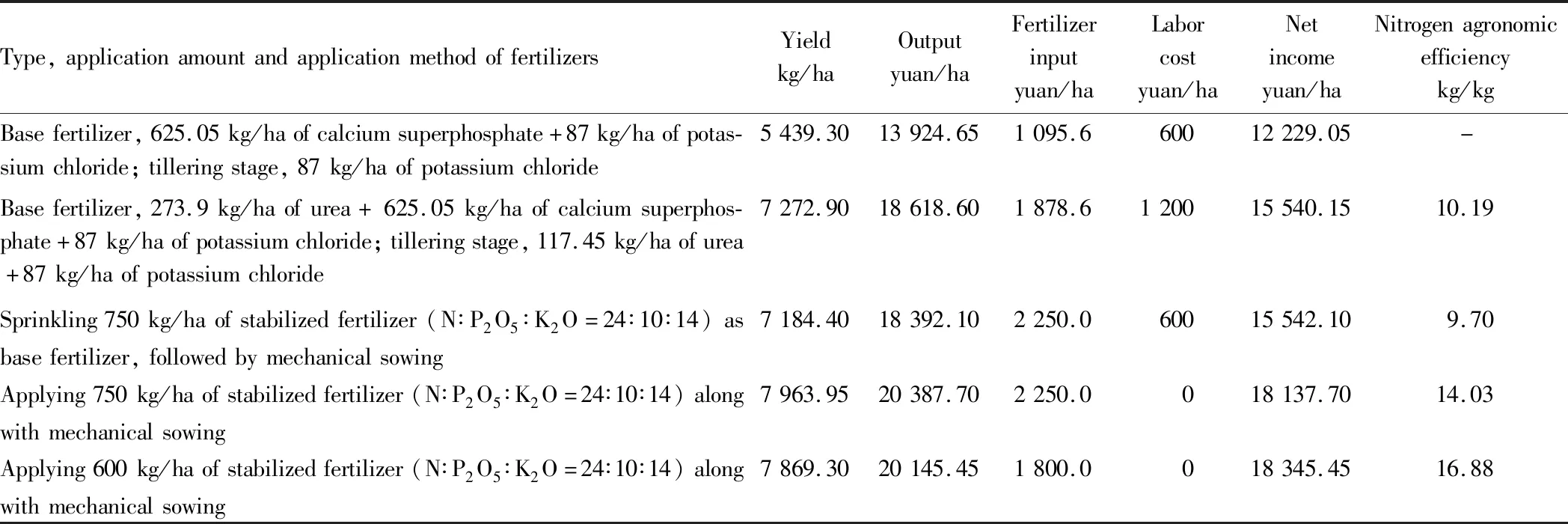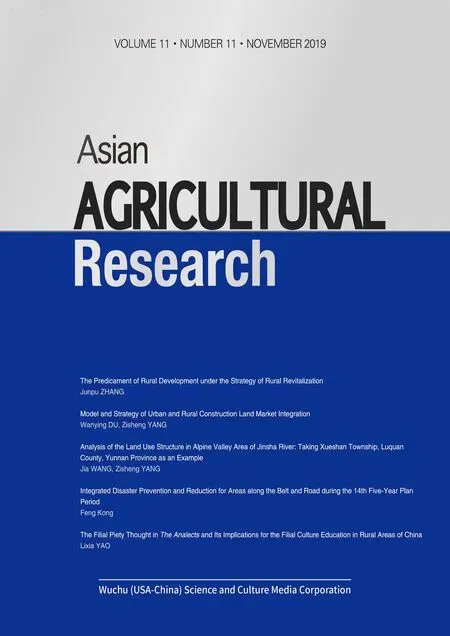Application Effects of Stabilized Fertilizer with Reduced Amount and Frequency on Rice
2019-12-17NanaFANG1LihongYU3ZongyunLU
Nana FANG1,2, Lihong YU3, Zongyun LU
1. Institute of Applied Ecology, Chinese Academy of Sciences, Shenyang 100016, China; 2. Shenyang Agricultural University, Shenyang 100016, China; 3. Liaoning Agricultural Development Service Center, Shenyang 110031, China
Abstract The activity of microorganisms in the soil can be adjusted through the application of stabilized fertilizer. Using biochemical means, the transformation of nitrogen in the soil is controlled, synchronizing the peak of nutrient released from soil and the peak of nutrient absorption by rice. With the application of stabilized fertilizer, the fertilizer utilization rate and the income of farmers can be improved and the environmental pollution can be cut down by reducing the amount of nitrogen fertilizer and decreasing the frequency of fertilization. This paper summarizes the application effects of stabilized fertilizer on different cultivars of rice in different regions for many years, and puts forward the issues to be concerned in the application of stabilized fertilizer with reduced amount and frequency and efficiency improvement techniques.
Key words Stabilized fertilizer, Rice, Fertilizer reduction, Efficiency improvement
1 Introduction
China is a big agricultural country, and nearly 60% of its population feeds on rice. Rice is undoubtedly one of the most important food crops in China[1-2]. As everyone knows, fertilizers contribute 50% of food production. However, due to the fact that there is still a certain gap in fertilizer utilization rate between China and developed countries (e.g. the utilization rate of nitrogen fertilizer in China is only 35%, while the utilization rate of nitrogen fertilizer in developed countries is above 50%), in order to increase food production and pursue economic benefits, farmers often apply excessive fertilizers especially nitrogen fertilizer. According to statistics, China’s rice planting area accounts for about 20% of the world’s rice planting area, but the use amount of nitrogen fertilizer in China accounts for 37% of the world’s total. The application rate of nitrogen fertilizer (pure nitrogen) in single-season rice fields of China is about 180 kg/ha[3], that is, the use of nitrogen fertilizer in rice fields of China has been at a relatively high level. Agricultural scholars at home and abroad have confirmed through exploration and research that excessive application of fertilizers, especially nitrogen fertilizer, will not increase production[4-5], and instead, it will cause spindling, late maturity, lodging, low grain plumpness, increased incidence of pests and diseases[6-9]in rice, as well as unnecessary waste of resources, land compaction, soil salinization and acidification. In particular, during the process, nitrogen fertilizer enters air, water and natural ecosystems through leaching, volatilization, denitrification and surface runoff, which adversely affects the environment and human health[4-5]. Stabilized fertilizer technology is a new fertilizer technology developed by the Institute of Applied Ecology, Chinese Academy of Sciences. In 2009-2018, 22 agricultural research institutes and universities across China were united to establish a stabilized fertilizer test and demonstration network and conducted pilot demonstrations for 33 crops including field crops, cash crops and fruits and vegetables. Particularly, they conducted long-term experimental demonstration on different cultivars of rice in different regions, and good results have been achieved.
2 Technical contents
Stabilized fertilizer is considered a new fertilizer in the 21st century. It is a new type of slow-released fertilizer suitable for Chinese agriculture. Making use of synergistic effects of urease inhibitors and nitrification inhibitors, stabilized fertilizer delays the hydrolysis of urea, increases the concentration of ammonia in soil and delays the release of nitrate nitrogen, synchronizing the peak of nutrient released from soil and the peak of nutrient absorption by crops, and thereby improving the utilization of nutrients and increasing the yield and quality of crop. The average utilization rate of nutrients has increased by 8.7 percentage points. Under the condition of same yield, the input of chemical fertilizers is reduced by 15%-20%; and under the condition of same fertilization, the yield of crops is increased by 10%-15%. At the same time, it reduces the loss of nutrients (leaching and volatilization) (e.g. the leaching rate of nutrients has been decreased by 48.2%), reduces the emission of N2O by 46%-74%, and reduces the pollution of water and the atmosphere by nitrate, nitrite and nitrous oxide. Stabilized fertilizer regulates the activity of microorganism in the soil through the action of inhibitors and controls the transformation of nitrogen in the soil by biochemical means. With the application of stabilized fertilizer, the fertilizer utilization rate and the income of farmers can be improved and the environmental pollution can be cut down by reducing the application amount of nitrogen fertilizer and reducing the times of fertilization. It has been proved that stabilized fertilizer can achieve fertilizer reduction and efficiency improvement in field crops, especially in maize and rice. Fertilizer reduction includes both reducing the amount of nutrients used and reducing the times of fertilization.
3 Role and effect of promotion and demonstration
3.1 Application effect of stabilized fertilizer in single-season rice in Northeast ChinaThe test results of the application of stabilized fertilizer in Hulan rice in Heilongjiang Province during 2009-2011 (Table 1) show that under conditions of equal-amount and 20% N reduced stabilized fertilizer once application, the ear length, grain number per ear, 1 000-grain weight, average yield of rice increased by 120-570 kg/ha, 1.51%-7.18% and income increased by 494.25-1 472.25 yuan/ha, compared with those in the conventional fertilization treatment. The percentage of empty-unfilled grains was reduced.
Table 1 Application effect of stabilized fertilizer in single-season rice in Hulan, Heilongjiang during 2009-2011

TreatmentApplicationmethodEarlengthcmTillernumberGrainnumberperearPercentageofempty-unfilledgrains∥%1000-grainweight∥gYieldkg/haIncreaseinyieldkg/haIncreaseinincomeyuan/haConventionalfertilizationBasefertilizer,375kg/haofcompoundfertilizer(N∶P2O5∶K2O=18∶15∶12);returninggreenstage,225kg/haofurea19.39.6173.111.6523.337935--Equal-amountstabilizedfertilizerBasefertilizer,600kg/haofstabilizedfertilizer(N∶P2O5∶K2O=26∶11∶11)19.69.9177.810.3224.3185055701472.25StabilizedfertilizerreductionBasefertilizer,480kg/haofstabilizedfertilizer(N∶P2O5∶K2O=26∶11∶11)19.49.2174.58.1124.138055120494.25
Note: The prices of rice, compound fertilizer, stabilized fertilizer and urea were 2.6 yuan/kg, 2 600, 3 600 and 2 200 yuan/t, respectively, and the cost of topdressing labor was 900 yuan/ha each time. The same as below.
3.2 Application effect of stabilized fertilizer in mid-season rice in Central ChinaDuring 2013-2015, the stabilized fertilizer was applied to mid-season rice (Jiahua No.1) in Xiaoche Village, Muji Town, Chaohu City, Anhui Province. The results (Table 2) show that compared with conventional fertilization, the treatments of equal-amount stabilized fertilizer-reduced topdressing and reduced stabilized fertilizer-reduced topdressing increased the yield of rice by 1.5%-7.3%, and increased the income by 1 437-2 145 yuan/ha.
Table 2 Application effect of stabilized fertilizer in mid-season rice (Jiahua No.1) in Muji Town, Chaohu City, Anhui Province during 2013-2015

TreatmentApplicationmethodYieldkg/haOutputyuan/haFertilizercostsyuan/haLaborcostsoftopdressingyuan/haNetincomeyuan/haConventionalfertilizationBasefertilizer,375kg/haofcompoundfertilizer(N∶P2O5∶K2O=15∶15∶15)+225kg/haofurea;tilleringstage,300kg/haofurea;earingstage,225kg/haofcompoundfertilizer+75kg/haofurea82502145028801800-Equal-amountstabilizedfertilizerandtopdressingreductionBasefertilizer,750kg/haofstabilizedfertilizer(N∶P2O5∶K2O=20∶10∶18)+75kg/haofurea;earingstage,150kg/haofurea88502301031959002145StabilizedfertilizerreductionandtopdressingreductionBasefertilizer,600kg/haofstabilizedfertilizer(N∶P2O5∶K2O=20∶10∶18)+75kg/haofurea;earingstage,150kg/haofurea83702176226559001437
3.3 Application effect of stabilized fertilizer in double-season rice in South ChinaDuring 2013-2016, the experiment on stabilized fertilizer was carried out in the double-season rice in Deqiao Town, Dingcheng District, Changde City, Hunan Province. For early rice, the schedule for conventional fertilization was as follows: base fertilizer, 375 kg/ha of ammonium bicarbonate; from two-leaf and one-heart stage to three-leaf and one-heart stage, 300 kg/ha of compound fertilizer (N∶P2O5∶K2O=25∶10∶16); and tillering stage, 90 kg/ha of urea. The application schedule for stabilized fertilizer was as follows: base fertilizer, 375 kg/ha of ammonium bicarbonate; from two-leaf and one-heart stage to three-leaf and one-heart stage, 300 kg/ha of stabilized fertilizer (N∶P2O5∶K2O=26∶11∶11); and tillering stage, 75 kg/ha of urea. For late rice, the schedule for conventional fertilization was as follows: base fertilizer, 600 kg/ha of compound fertilizer (N∶P2O5∶K2O=25∶10∶16); and tillering stage, 75 kg/ha of urea. A total amount of 750 kg/ha of stabilized fertilizer (N∶P2O5∶K2O=24∶10∶14) was applied as base fertilizer. As shown in Table 3, under the condition of reducing 5.8% of nutrients or reducing one time of topdressing, the yield of the early rice Xiangzaoxian 45 and late rice Huanghuazhan and Fengyuanyou was increased by 621 (8.9%), 525 (6.9%) and 1 090.5 (13.5%) kg/ha, respectively compared with that in the conventional fertilization group. Reducing the amount and frequency of fertilization can save labor costs. Therefore, under the condition of applying stabilized fertilizer, the income of early rice was increased by 1 347.75 yuan/ha, and the income of late rice was increased by 524.25-2 013.75 yuan/ha.
In 2011, the effects of different application methods of stabilized fertilizer on the late rice Wanxian 98 were studied in Chibi City, Hubei Province, and the results are shown in Table 4. Compared with sprinkling of conventional fertilizer, the yield of rice slightly decreased (by 1.22%) under the sprinkling of stabilized fertilizer. The yield of the rice was highest (7 963.95 kg/ha) under mechanized application of equal-amount stabilized fertilizer, increased by 9.5%. Under mechanized application of 80% of stabilized fertilizer, the yield of the rice increased by 8.2%. Conventional fertilization often requires multiple times, requiring more labor costs. Although the cost of stabilized fertilizer was highest, the income of the rice under mechanized application of 80% of stabilized fertilizer was the highest (18 345.45 yuan/ha), increased by 2 805.45 yuan/ha compared with conventional sprinkling. The income of rice under mechanized application of 80% of stabilized fertilizer was increased by 2 597.7 yuan/ha, and that under sprinkling of stabilized fertilizer was increased only 2.1 yuan/ha. The nitrogen agronomic efficiency of mechanized application of 80% stabilized fertilizer was the highest (16.88 kg/kg), followed by mechanized application of equal-amount stabilized fertilizer. The results show that the adoption of appropriate deep application measures could better exert the effect of stabilized fertilizer on crop yield, meanwhile, it also reduced fertilizer use by 20% and reduced topdressing by one time. Therefore, in the application of stabilized fertilizer, more attention should be paid to the combination with fertilization methods.
Table 3 Application effect of stabilized fertilizer in double-season rice in Changde City, Hunan Province

RiceCultivarTreatmentYieldkg/haFertilizerinputyuan/haLaborinputyuan/haOutputyuan/haIncomeyuan/haNetincomeyuan/haEarlyriceXiangzaoxian45Conventionalstabilizedfertilizer6987.001282.5030018166.516239.0-LatericeHuanghuazhanConventionalstabilizedfertilizer7607.851548.7530019780.517661.01347.75Fengyuanyou2297Conventionalstabilizedfertilizer7584.751728.7515019720.517151.0-8109.302700.00-21084.017709.0542.258085.601728.7515021022.518453.0-9175.952700.00-23857.520482.52013.75
Table 4 Application effect of stabilized fertilizer in late rice Wanxian 98 in Chibi City, Hubei Province in 2011

Type,applicationamountandapplicationmethodoffertilizersYieldkg/haOutputyuan/haFertilizerinputyuan/haLaborcostyuan/haNetincomeyuan/haNitrogenagronomicefficiencykg/kgBasefertilizer,625.05kg/haofcalciumsuperphosphate+87kg/haofpotas-siumchloride;tilleringstage,87kg/haofpotassiumchloride5439.3013924.651095.660012229.05-Basefertilizer,273.9kg/haofurea+625.05kg/haofcalciumsuperphos-phate+87kg/haofpotassiumchloride;tilleringstage,117.45kg/haofurea+87kg/haofpotassiumchloride7272.9018618.601878.6120015540.1510.19Sprinkling750kg/haofstabilizedfertilizer(N∶P2O5∶K2O=24∶10∶14)asbasefertilizer,followedbymechanicalsowing7184.4018392.102250.060015542.109.70Applying750kg/haofstabilizedfertilizer(N∶P2O5∶K2O=24∶10∶14)alongwithmechanicalsowing7963.9520387.702250.0018137.7014.03Applying600kg/haofstabilizedfertilizer(N∶P2O5∶K2O=24∶10∶14)alongwithmechanicalsowing7869.3020145.451800.0018345.4516.88
4 Issues to be concerned in the application of stabilized fertilizer in rice
In rice cultivation process, the application of stabilized fertilizer should follow the following rules.
4.1 Total input of nitrogen fertilizer should not be lower than 80% of the conventional fertilization amountThe growth of rice has the most demand for nitrogen, and it is also more sensitive to nitrogen supply in key period. In the process of reducing the amount of stabilized fertilizer, the basic soil fertility and climate should be considered. In order to achieve equal production or a light increase in production, the application amount of stabilized fertilizer should not be less than 80% of the conventional fertilization amount.
4.2 Base fertilizer should be fully applied or mechanically positioned before harrowingThe results of many years of research prove that the stabilized fertilizer has the best effect in deep application. Therefore, when used as base fertilizer, stabilized fertilizer should be applied deeply. It is better for base fertilizer to be fully applied or mechanically positioned before harrowing.
4.3 It is best to topdress in the tillering or pre-booting stage
A large amount of nitrogen, phosphorus and potassium nutrients are needed in the tillering or booting stage of rice, during which rice is most sensitive to nitrogen. Therefore, in these two stages, it is necessary to topdress according to the actual situation or the local farmers’ fertilization habits.
4.4 This technology is not applicable to water leaking paddy fieldsWater leaking paddy fields will cause a large loss of nutrients. In this case, rice yield may be reduced when the application of stabilized fertilizer is reduced. Therefore, this technique is not applicable to water leaking paddy fields.
杂志排行
Asian Agricultural Research的其它文章
- Characteristics of Changes in Energy Consumption of Rural Residential Buildings from the Perspective of Province and Recommendations
- Contents of Heavy Metals in Typical Aquatic Products from a Market in Binzhou
- Analysis of the Land Use Structure in Alpine Valley Area of Jinsha River: Taking Xueshan Township, Luquan County, Yunnan Province as an Example
- Assessment on Ecological Capital of Small Towns: A Case Study of Baita Town, Weifang
- Yield Gap Analysis of Wheat in Rice-wheat Rotation Regions of Anhui Province, China
- Effects of Different Storage Temperatures on Shelf Life and Quality of Strawberry Fruit after Hot Water Treatment
